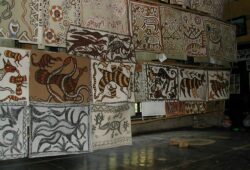Kalamkari Painting: A Journey of Timeless Artistry
 Posted On
Posted On
Kalamkari, an ancient art form with roots in India, is a unique style of hand-painted or block-printed cotton fabric known for its intricate designs and vibrant colours. The word ‘Kalamkari’ is derived from two Persian words, ‘Kalam’ (pen) and ‘Kari’ (craftsmanship), reflecting the art’s primary technique of using a pen-like instrument to draw intricate patterns. This article explores the fascinating history, techniques, and significance of Kalamkari painting, which has survived through centuries and continues to enchant art enthusiasts worldwide.
Historical Origins
The history of Kalamkari can be traced back to ancient India, with some records dating as far back as the 3rd century BCE. This art form thrived in various regions, including Andhra Pradesh and Telangana in South India and the ancient port city of Machilipatnam. Over time, the art form also influenced other cultures, such as the Persian and Mughal civilizations, which added their unique touch to the art’s development.
Techniques and Execution
Kalamkari artists employ two distinct techniques to create their masterpieces: Srikalahasti and Machilipatnam styles.
Srikalahasti Style: This technique involves freehand drawing with a pen-like instrument called a kalam (hence the name Kalamkari). The kalam is a bamboo or palm reed with a sharp point that allows the artist to draw intricate lines and fine details. The colours used in this style are derived from natural dyes made from plant-based sources, such as indigo, madder root, and pomegranate.
Machilipatnam Style: In this style, the artist employs block printing along with hand-painted elements. The designs are carved onto wooden blocks, and the artisans use them to transfer the patterns onto the fabric. After the block printing, the artists add finer details and nuances through hand painting.
Themes and Motifs
Kalamkari paintings often depict mythological stories, religious figures, epic scenes from the Ramayana and Mahabharata, as well as floral and nature-inspired motifs. The themes carry rich symbolism and spiritual significance, making each artwork not only visually appealing but also a reflection of cultural heritage and spirituality.
Revival and Modern Adaptations
Like many traditional art forms, Kalamkari faced challenges and decline during the colonial era. However, the dedication of skilled artisans and art enthusiasts led to a revival of interest in this exquisite art form. In recent times, Kalamkari has experienced a resurgence and has been adapted into various forms, such as sarees, garments, home furnishings, and even contemporary art pieces.
Global Appreciation
The mesmerizing beauty of Kalamkari has garnered global attention, leading to its recognition as a significant contribution to the world of art. international exhibitions and collaborations with renowned designers and artists have exposed Kalamkari to a broader audience, making it a sought-after collectible for art lovers worldwide.
Preservation and Challenges
While Kalamkari has experienced a resurgence, it still faces challenges, including competition from machine-printed fabrics, the rising cost of natural dyes, and the need for sustainable livelihoods for artisans. Organizations and government initiatives have played a vital role in supporting these artists, preserving traditional techniques, and providing a platform for their work to thrive.
Kalamkari painting stands as a testament to the enduring spirit of human creativity and ingenuity. It reflects the rich cultural heritage of India and serves as a bridge between the past and the present. With its intricacy, vivid colours, and spiritual themes, Kalamkari continues to inspire awe and appreciation from art enthusiasts worldwide, ensuring that this timeless art form remains a cherished legacy for generations to come.



